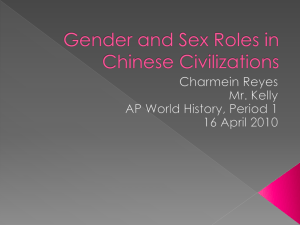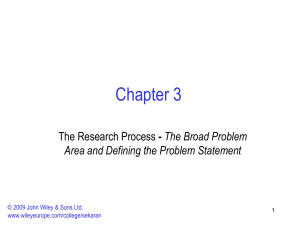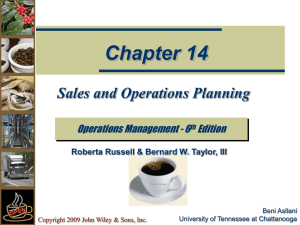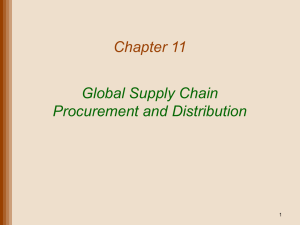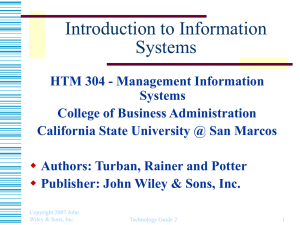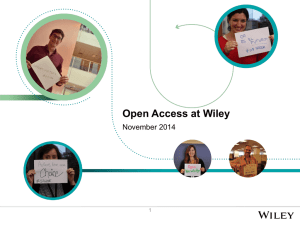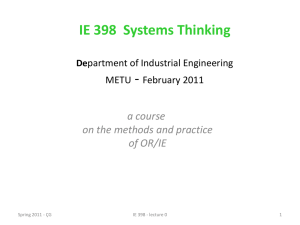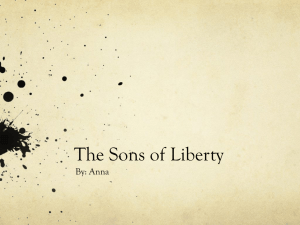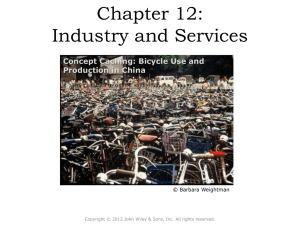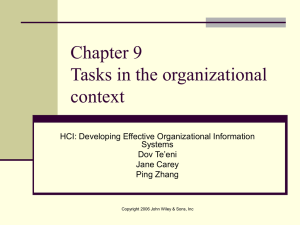Parte 3 Elettronica di potenza: a.Sistemi elettronici
advertisement
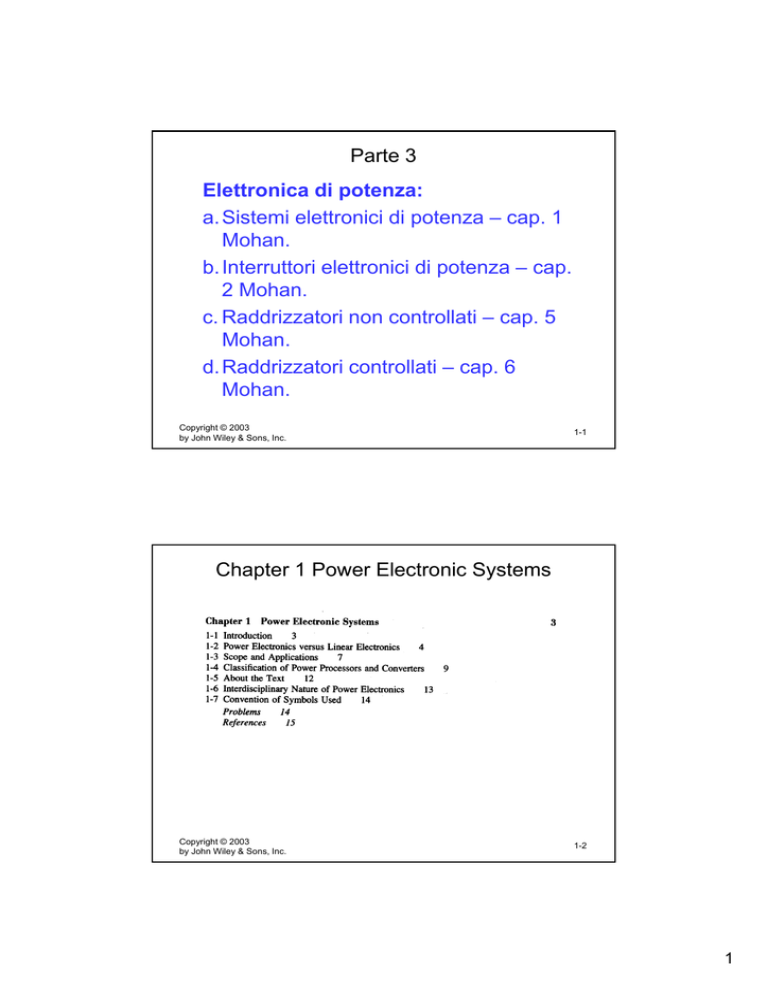
Parte 3 Elettronica di potenza: a. Sistemi elettronici di potenza – cap. 1 M h Mohan. b. Interruttori elettronici di potenza – cap. 2 Mohan. c. Raddrizzatori non controllati – cap. 5 Mohan Mohan. d. Raddrizzatori controllati – cap. 6 Mohan. Copyright © 2003 by John Wiley & Sons, Inc. 1-1 Chapter 1 Power Electronic Systems Copyright © 2003 by John Wiley & Sons, Inc. 1-2 1 Power Electronic Systems • Block diagram • Role of Power Electronics • Reasons for growth Copyright © 2003 by John Wiley & Sons, Inc. 1-3 Linear Power Supply • Series transistor as an adjustable resistor • Low Efficiency • Heavy and bulky Copyright © 2003 by John Wiley & Sons, Inc. 1-4 2 Switch-Mode Power Supply • Transistor as a switch • High Efficiency • High-Frequency Transformer Copyright © 2003 by John Wiley & Sons, Inc. 1-5 Basic Principle of Switch-Mode Synthesis • Constant switching frequency • pulse width controls the average • L-C filters the ripple Copyright © 2003 by John Wiley & Sons, Inc. 1-6 3 Application in Adjustable Speed Drives • • Conventional drive wastes energy across the throttling valve to adjust flow rate Using power electronics, motor-pump speed is adjusted efficiently to deliver the required flow rate Copyright © 2003 by John Wiley & Sons, Inc. 1-7 Scope and Applications Copyright © 2003 by John Wiley & Sons, Inc. 1-8 4 Power Processor as a Combination of Converters • Most practical topologies require an energy storage element, which also decouples the input and the output side converters Copyright © 2003 by John Wiley & Sons, Inc. 1-9 Power Flow through Converters • Converter is a g general term • An ac/dc converter is shown here • Rectifier Mode of operation when power from ac to dc • Inverter Mode of operation when power from ac to dc Copyright © 2003 by John Wiley & Sons, Inc. 1-10 5 AC Motor Drive • Converter 1 rectifies line-frequency ac into dc • Capacitor acts as a filter; stores energy; decouples • Converter 2 synthesizes low-frequency ac to motor • Polarity of dc-bus voltage remains unchanged – ideally suited for transistors of converter 2 Copyright © 2003 by John Wiley & Sons, Inc. 1-11 Matrix Converter • Very general structure • Would benefit from bi-directional and bi-polarity switches • Being considered for use in specific applications Copyright © 2003 by John Wiley & Sons, Inc. 1-12 6 Interdisciplinary Nature of Power Electronics Copyright © 2003 by John Wiley & Sons, Inc. 1-13 Chapter 2 Overview of Power Semiconductor Devices Copyright © 2003 by John Wiley & Sons, Inc. 1-14 7 Diodes • On and off states controlled by the power circuit Copyright © 2003 by John Wiley & Sons, Inc. 1-15 Diode Turn-Off • Fast-recovery diodes have a small reverse-recovery time Copyright © 2003 by John Wiley & Sons, Inc. 1-16 8 Thyristors • Semi-controlled device • Latches ON by a gate-current pulse if forward biased • Turns-off if current tries to reverse Copyright © 2003 by John Wiley & Sons, Inc. 1-17 Thyristor in a Simple Circuit • For successful turn-off, reverse voltage required for an interval greater than the turn-off interval Copyright © 2003 by John Wiley & Sons, Inc. 1-18 9 Generic Switch Symbol • Idealized switch symbol • When Wh on, currentt can flow fl only l in i the th direction di ti off the th arrow • Instantaneous switching from one state to the other • Zero voltage drop in on-state • Infinite voltage and current handling capabilities Copyright © 2003 by John Wiley & Sons, Inc. 1-19 Switching Characteristics (linearized) Switching Power Loss is proportional p p to: • switching frequency • turn-on and turn-off times Copyright © 2003 by John Wiley & Sons, Inc. 1-20 10 Bipolar Junction Transistors (BJT) • Used commonly in the past • Now used in specific applications • Replaced by MOSFETs and IGBTs Copyright © 2003 by John Wiley & Sons, Inc. 1-21 Various Configurations of BJTs Copyright © 2003 by John Wiley & Sons, Inc. 1-22 11 MOSFETs • Easy to control by the gate • Optimal for low-voltage operation at high switching frequencies • On-state resistance a concern at higher voltage ratings Copyright © 2003 by John Wiley & Sons, Inc. 1-23 Gate-Turn-Off Thyristors (GTO) • Slow switching speeds • Used at very high power levels • Require elaborate gate control circuitry Copyright © 2003 by John Wiley & Sons, Inc. 1-24 12 GTO Turn-Off • Need a turn-off snubber Copyright © 2003 by John Wiley & Sons, Inc. 1-25 IGBT Copyright © 2003 by John Wiley & Sons, Inc. 1-26 13 Comparison of Controllable Switches Copyright © 2003 by John Wiley & Sons, Inc. 1-27 Summary of Device Capabilities Copyright © 2003 by John Wiley & Sons, Inc. 1-28 14 Chapter 5 Diode Rectifiers Copyright © 2003 by John Wiley & Sons, Inc. 1-29 Diode Rectifier Block Diagram • Uncontrolled utility interface (ac to dc) Copyright © 2003 by John Wiley & Sons, Inc. 1-30 15 A Simple Circuit • Resistive load Copyright © 2003 by John Wiley & Sons, Inc. 1-31 A Simple Circuit (R-L Load) • Current continues to flows for a while even after the input voltage has gone negative Copyright © 2003 by John Wiley & Sons, Inc. 1-32 16 A Simple Circuit (Load has a dc back-emf) • Current begins to flow when the input voltage exceeds the dc back-emf • Current continues to flows for a while even after the input voltage has gone below the dc back-emf Copyright © 2003 by John Wiley & Sons, Inc. 1-33 Single-Phase Diode Rectifier Bridge • Large capacitor at the dc output for filtering and energy storage Copyright © 2003 by John Wiley & Sons, Inc. 1-34 17 Diode-Rectifier Bridge Analysis • Two simple (idealized) cases to begin with Copyright © 2003 by John Wiley & Sons, Inc. 1-35 Redrawing Diode-Rectifier Bridge • Two groups, each with two diodes Copyright © 2003 by John Wiley & Sons, Inc. 1-36 18 Waveforms with a purely resistive load and a purely dc current at the output • In both cases, the dc-side voltage waveform is the same Copyright © 2003 by John Wiley & Sons, Inc. 1-37 Diode-Rectifier Bridge Input Current • Idealized case with a purely dc output current Copyright © 2003 by John Wiley & Sons, Inc. 1-38 19 Diode-Rectifier Bridge Analysis with ACSide Inductance • Output current is assumed to be purely dc Copyright © 2003 by John Wiley & Sons, Inc. 1-39 Understanding Current Commutation • Assuming inductance in this circuit to be zero Copyright © 2003 by John Wiley & Sons, Inc. 1-40 20 Understanding Current Commutation (cont.) • Inductance in this circuit is included Copyright © 2003 by John Wiley & Sons, Inc. 1-41 Current Commutation Waveforms • Shows the volt-seconds needed to commutate current Copyright © 2003 by John Wiley & Sons, Inc. 1-42 21 Current Commutation in Full-Bridge Rectifier • Shows the necessary volt-seconds Copyright © 2003 by John Wiley & Sons, Inc. 1-43 Understanding Current Commutation • Note the current loops for analysis Copyright © 2003 by John Wiley & Sons, Inc. 1-44 22 Rectifier with a dcside voltage Copyright © 2003 by John Wiley & Sons, Inc. 1-45 Diode-Rectifier with a Capacitor Filter • Power electronics load is represented by an equivalent load resistance Copyright © 2003 by John Wiley & Sons, Inc. 1-46 23 Diode Rectifier Bridge • Equivalent circuit for analysis on one-half cycle basis Copyright © 2003 by John Wiley & Sons, Inc. 1-47 Diode-Bridge Rectifier: Waveforms • Analysis using MATLAB Copyright © 2003 by John Wiley & Sons, Inc. 1-48 24 Diode-Bridge Rectifier: Waveforms • Analysis using PSpice Copyright © 2003 by John Wiley & Sons, Inc. 1-49 Input Line-Current Distortion • Analysis using PSpice Copyright © 2003 by John Wiley & Sons, Inc. 1-50 25 Line-Voltage Distortion • PCC is the point of common coupling Copyright © 2003 by John Wiley & Sons, Inc. 1-51 Line-Voltage Distortion • Distortion in voltage supplied to other loads Copyright © 2003 by John Wiley & Sons, Inc. 1-52 26 Chapter 6 Thyristor Converters • Controlled conversion of ac into dc Copyright © 2003 by John Wiley & Sons, Inc. 1-53 Thyristor Converters • Two-quadrant conversion Copyright © 2003 by John Wiley & Sons, Inc. 1-54 27 Primitive circuits with thyristors Copyright © 2003 by John Wiley & Sons, Inc. 1-55 Thyristor Triggering • ICs available Copyright © 2003 by John Wiley & Sons, Inc. 1-56 28 Full-Bridge Thyristor Converters • Single-phase and three-phase Copyright © 2003 by John Wiley & Sons, Inc. 1-57 Single-Phase Thyristor Converters • Two groups with two thyristor each Copyright © 2003 by John Wiley & Sons, Inc. 1-58 29 1-Phase Thyristor Converter Waveforms • Assuming zero ac-side inductance Copyright © 2003 by John Wiley & Sons, Inc. 1-59 Average DC Output Voltage • Assuming zero ac-side inductance Copyright © 2003 by John Wiley & Sons, Inc. 1-60 30 Input Line-Current Waveforms • Harmonics, power and reactive power Copyright © 2003 by John Wiley & Sons, Inc. 1-61 1-Phase Thyristor Converter • Finite ac-side inductance; constant dc output current Copyright © 2003 by John Wiley & Sons, Inc. 1-62 31 Thyristor Converter Waveforms • Finite ac-side inductance Copyright © 2003 by John Wiley & Sons, Inc. 1-63 Thyristor Converter: continuous Mode • This mode can occur in a dc-drive at light loads Copyright © 2003 by John Wiley & Sons, Inc. 1-64 32 Thyristor Converter Waveforms • PSpice-based simulation Copyright © 2003 by John Wiley & Sons, Inc. 1-65 Thyristor Converter Waveforms: Discontinuous Conduction Mode • PSpice-based simulation Copyright © 2003 by John Wiley & Sons, Inc. 1-66 33 Thyristor Converters: Inverter Mode • Assuming the ac-side inductance to be zero Copyright © 2003 by John Wiley & Sons, Inc. 1-67 34
